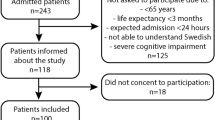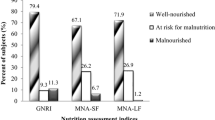Abstract
Background
Malnutrition is a common problem in older patients. Early detection of malnutrition is an important task in clinical practice. The MNA has become an extensively used tool to evaluate nutritional status in European countries and the United States.
Objective
We evaluated the Mini-Nutritional Assessment (MNA) test and the short-form MNA (MNA-SF) test as screening tools for malnutrition in older Chinese inpatients and focused on finding an optimal cutoff point for MNA total score and MNA-SF score.
Design
One hundred eighty-four older Chinese inpatients were enrolled in this study from July to August 2006. Nutritional assessment included MNA, anthropometric measurements, and biochemical markers.
Results
According to the original cutoff point of the full MNA, 19.6% of those assessed were malnourished, 53.2% were at risk of malnutrition and 27.2% were well nourished. Correlations were found between MNA, MNA-SF and body mass index, triceps skinfold thickness, serum albumin, lymphocyte count, hemoglobin, lymphocyte ratio. With the most proper cutoff point lower than 19 indicating malnutrition, when using serum albumin (<35.0 g/L) as the indicator, the sensitivity and specificity of the MNA total score were 0.6286 and 0.7466; when using BMI (<18.5 kg/m2) as the indicator, the sensitivity and specificity were 0.8636 and 0.7469. The incidence rate of malnutrition was 32.6%. The most proper cutoff point of MNA-SF was lower than 12.
Conclusion
The MNA and MNA-SF were useful tools to identify older Chinese inpatients with malnutrition. However, the cutoff point of the MNA should be modulated for this population.
Similar content being viewed by others
References
Corish CA & Kennedy NP. (2000) Protein-energy undernutrition in hospital inpatients. Br J Nutr 83, 575–591.
Yu K & Chen W. (1999) The Nutritional Assessment of Surgical Elderly Inpatients. Acta Nutrimenta Sinica 21, 212–215.
Green SM & Watson R. (2006) Nutritional screening and assessment tools for older adults: literature review. J Adv Nurs 54, 477–490.
Guigoz Y, Vallas BJ & Garry PJ. (1996) Assessing the nutritional status of the elderly: the Mini-Nutritional Assessment as part of the geriatric evaluation. Nutr Rev 54, 59–65.
Charlton KE, Kolbe-Alexander TL & Nel JH. (2007) The MNA, but not the DETERMINE, screening tool is a valid indicator of nutritional status in elderly Africans. Nutrition 23,533–542
Kabir ZN, Ferdous T, Cederholm T, Khanam MA, Streatfied K, Wahlin A. (2006) Mini Nutritional Assessment of rural elderly people in Bangladesh: the impact of demographic, socio-economic and health factors. Public Health Nutr 9, 968–974.
Rubenstein LZ, Harber JO & Salva A. (2001) Screening for undernutrition in geriatric practice: developing the short-form mini-nutritional assessment (MNA-SF). Gerontology: Medical Sciences 56, 366–372.
Vellas B, Guigoz Y & Garry PJ. (1999) The mini nutritional assessment (MNA) and its use in grading the nutritional state of elderly patients. Nutrition 15, 116.
Liao EY & Chao CS. (2001) Endocrinology. The People’s Health Publishing House, Beijing, 1767–1973.
Chen CM & Shao ZM. (1994) The status of food nutrition and health in seven provinces in China. China Statistical Publishing House, Beijing.
Yin QF, Chen WK & Mo ZF. (2005) Nutrition status evaluation of 280 in-patients. Modern Hospital 5, 26–27.
Wang L, Li YY & Jiang W. (2005) A study of nutritional assessment for the long term hospitalized elderly patients. Chinese Journal of Geriatrics 24, 589–591.
Sungurtekin H, Sungurtekin U, Balci C, Zencir M, Erdem E.(2004) The influence of nutritional status on complications after major intra-abdominal surgery. J Am Coll Nutr 23,227–232.
Chen CH, Schilling LS & Lyder CH. (2001) A concept analysis of malnutrition in the elderly. J Adv Nurs 36, 131–142.
He YL, Jian ZJ & Ouyang M. (2004) Using Mini-Nutritional Assessment to Investigate the Nutritional Status of the Aged Hospitalized Patients. Chinese Journal of Clinical Nutrition 12, 93–96.
Author information
Authors and Affiliations
Corresponding author
Rights and permissions
About this article
Cite this article
Lei, Z., Qingyi, D., Feng, G. et al. Clinical study of Mini-Nutritional Assessment for older Chinese inpatients. J Nutr Health Aging 13, 871–875 (2009). https://doi.org/10.1007/s12603-009-0244-1
Received:
Accepted:
Published:
Issue Date:
DOI: https://doi.org/10.1007/s12603-009-0244-1




